Harvard University is an American private Ivy League research university located in Cambridge, Massachusetts,
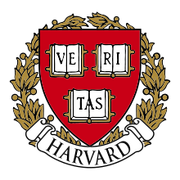
Seal of Harvard University
United States, established in 1636 by the Massachusetts legislature. Harvard is the oldest institution of higher learning in the United States and the first corporation (officially The President and Fellows of Harvard College) chartered in the country. Harvard's history, influence, and wealth have made it one of the most prestigious universities in the world.
Harvard was named after its first benefactor, John Harvard. Although never formally affiliated with a church, the college primarily trained Congregationalist and Unitarian clergy. Harvard's curriculum and students became secular throughout the 18th century and by the 19th century had emerged as the central cultural establishment among Boston elites. Following the American Civil War, President Charles W. Eliot's forty-year tenure (1869–1909) transformed the college and affiliated professional schools into a centralized research university, and Harvard became a founding member of the Association of American Universities in 1900. James Bryant Conant led the university through the Great Depression and World War II and began to reform the curriculum and liberalize admissions after the war. The undergraduate college became coeducational after its 1977 merger with Radcliffe College. Drew Gilpin Faust was elected the 28th president in 2007 and is the first woman to lead the university. Harvard has the largest financial endowment of any academic institution in the world, standing at $32 billion as of September 2011.
Organization and administration[]
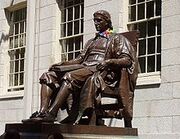
John Harvard Statue
The Faculty of Arts and Sciences is primarily responsible for instruction in Harvard College, Graduate School of Arts and Sciences, and the Harvard Division of Continuing Education, which includes Harvard Summer School and Harvard Extension School. There is also the Radcliffe Institute for Advanced Study.Harvard is governed by a combination of its Board of Overseers and the President and Fellows of Harvard College (also known as the Harvard Corporation), which in turn appoints the President of Harvard University. There are 16,000 staff and faculty.A faculty of approximately 2,410 professors, lecturers, and instructors serve as of school year 2009–10, with 7,180 undergraduate and 13,830 graduate students. The school color is crimson, which is also the name of the Harvard sports teams and the daily newspaper, The Harvard Crimson. The color was unofficially adopted (in preference to magenta) by an 1875 vote of the student body, although the association with some form of red can be traced back to 1858, when Charles William Eliot, a young graduate student who would later become Harvard's 21st and longest-serving president (1869–1909), bought red bandanas for his crew so they could more easily be distinguished by spectators at a regatta.Joint programs with the Massachusetts Institute of Technology include the Harvard-MIT Division of Health Sciences and Technology, the Broad Institute, The Observatory of Economic Complexity, and edX.
Campus[]
Harvard's 210-acre (85 ha) main campus is centered on Harvard Yard in Cambridge, approximately 3.4 miles
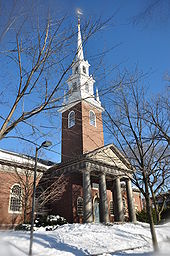
Memorial Church
(5.5 km) northwest of downtown Boston and extends into the surrounding Harvard Square neighborhood. Harvard Yard itself contains the central administrative offices and main libraries of the university, academic buildings including Sever Hall and University Hall, Memorial Church, and the majority of the freshman dormitories. Sophomore, junior, and senior undergraduates live in twelve residential Houses, nine of which are south of Harvard Yard along or near the Charles River. The other three are located in a residential neighborhood half a mile northwest of the Yard at the Quadrangle (commonly referred to as the Quad), which formerly housed Radcliffe College students until Radcliffe merged its residential system with Harvard. The Harvard MBTA station provides public transportation via bus service and the Red Line subway. The Harvard Business School and many of the university's athletics facilities, including Harvard Stadium, are located on a 359-acre (145 ha) campus opposite the Cambridge campus in Allston. The John W. Weeks Bridge is a pedestrian bridge over the Charles River connecting both campuses. The Harvard Medical School, Harvard School of Dental Medicine,and the Harvard School of Public Health are located on a 22-acre (8.9 ha) campus in the Longwood Medical and Academic Area approximately 3.3 miles (5.3 km) southwest of downtown Boston and 3.3 miles (5.3 km) south of the Cambridge campus.

Harvard Yard in the winter
A private shuttle bus connects the Longwood campus to the Cambridge campus via Massachusetts Avenue making stops in the Back Bay and at MIT as well.Each residential house contains rooms for undergraduates, House masters, and resident tutors, as well as a dining hall, library, and various other student facilities. The facilities were made possible by a gift
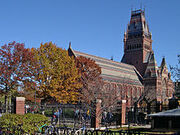
Memorial Hall
from Yale University alumnus Edward Harkness.Radcliffe Yard, formerly the center of the campus of Radcliffe College

Harvard yard as seen from the Holyoke Center
(and now home of the Radcliffe Institute), is adjacent to the Graduate School of Education and the Cambridge Common.
From 2009–2011, Harvard University reported on-campus crime statistics that included 69 forcible sex offenses, 12 robberies, 15 aggravated assaults, 80 burglaries, and 10 cases of motor vehicle theft.
Academics[]
Harvard is a large, highly residential research university. The university has beenaccredited by the New England Association of Schools and Colleges since 1929. The university offers 46 undergraduate concentrations (majors),

Massachusetts Hall
134 graduate degrees, and 32 professional degrees. For the 2008–2009 academic year, Harvard granted 1,664 baccalaureate degrees, 400 masters degrees, 512 doctoral degrees, and 4,460 professional degrees. The four year, full-time undergraduate program comprises a minority of enrollments at the university and emphasizes instruction with an "arts & sciences focus." Between 1978 and 2008, entering students were required to complete a "Core Curriculum" of seven classes outside of their concentration. Since 2008, undergraduate students have been required to complete courses in eight General Education categories: Aesthetic and Interpretive Understanding, Culture and Belief, Empirical and Mathematical Reasoning, Ethical Reasoning, Science of Living Systems, Science of the Physical Universe, Societies of the World, and United States in the World. Harvard offers a comprehensive doctoral graduate program and there is a high level of coexistence between graduate and undergraduate degrees. The Carnegie Foundation for the Advancement of Teaching, The New York Times, and some students have criticized Harvard for its reliance on teaching fellows for some aspects of undergraduate education; they consider this to adversely affect the quality of education.Harvard's academic programs operate on a semester calendar beginning in early September and ending in mid-May. Undergraduates typically take four half-courses per term and must maintain a four-course rate average to be considered full-time. In many concentrations, students can elect to pursue a basic program or an honors-eligible program requiring a senior thesis and/or advanced course work. Students graduating in the top 4–5% of the
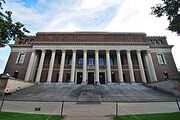
Harry Elkins Widener Memorial
class are awarded degrees summa cum laude, students in the next 15% of the class are awarded magna cum laude, and the next 30% of the class are awarded cum laude. Harvard has chapters of academic honor societies such as Phi Beta Kappa and various committees and departments also award several hundred named prizes annually. Harvard, along with other universities, has been accused of grade inflation, although there is evidence that the quality of the student body and its motivation have also increased. Harvard College reduced the number of students who receive Latin honors from 90% in 2004 to 60% in 2005. Moreover, the honors of "John Harvard Scholar" and "Harvard College Scholar" will now be given only to the top 5 percent and the next 5 percent of each class.
Undergraduate tuition for the 2009–2010 school year was $33,696 and the total cost with fees, room, and board was $48,868. Under financial aid guidelines adopted in 2007, parents in families with incomes of less than $60,000 will no longer be expected to contribute any money to the cost of attending Harvard for their children, including room and board. Families with incomes in the $60,000 to $80,000 range contribute an amount of only a few thousand dollars a year. In December 2007, Harvard announced that families earning between $120,000 and $180,000 will only have to pay up to 10% of their annual household income towards tuition. In 2009, Harvard offered grants totaling $414.1 million across all 11 divisions; $339.5 million came from institutional funds, $35.3 million from federal support, and $39.2 million from other outside support. Grants total 87.7% of Harvard's aid for undergraduate students, with aid also provided by loans (8.4%) and work-study (3.9%).